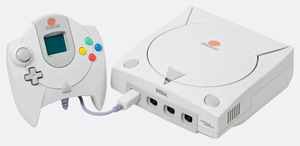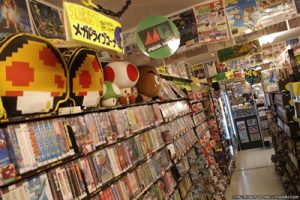I was staying with the in-laws after returning to Japan from Australia, having recently been married and having sold a large collection of (mostly PAL), video games and systems to pay for the wedding. I got into collecting a little before the retro collecting craze, pushed largely by YouTube personalities, made it expensive. I was reluctantly cashing out early but not so early that I didn’t see some profit in sales. I had held on to some stuff, but I needed to find a new hobby to replace it — or so I thought.
 Upstairs, my wife was going through cupboards looking for items she’d need for our next move. I became involved and soon the former managing director of Sega, Hidekazu Yukawa was staring back at me. I didn’t know who he was at the time, but I immediately realised what was in the box that his portrait decorated the back of. It was a Japanese Sega Dreamcast with two controllers and three or four games. I wasn’t shy about inquiring whether or not I could have it, and it was with a mixture of joy and surprise that I was told I could and that my mother-in-law had referred to it as “trash.” How could she say such things? No sooner was I out of collecting then this long-forgotten Dreamcast in a beat up box had pulled me back in.
Upstairs, my wife was going through cupboards looking for items she’d need for our next move. I became involved and soon the former managing director of Sega, Hidekazu Yukawa was staring back at me. I didn’t know who he was at the time, but I immediately realised what was in the box that his portrait decorated the back of. It was a Japanese Sega Dreamcast with two controllers and three or four games. I wasn’t shy about inquiring whether or not I could have it, and it was with a mixture of joy and surprise that I was told I could and that my mother-in-law had referred to it as “trash.” How could she say such things? No sooner was I out of collecting then this long-forgotten Dreamcast in a beat up box had pulled me back in.
This was the beginning of my hobby collecting Japanese games, and only a little while later I added complete copies of Sega Rally 2 and Sonic Adventure to my small collection for a few hundred yen. It wouldn’t be until three or four years later that I started collecting with more intention though. By this time in the overseas markets, prices had gone way up and someone who simply wanted the console they played as a child was looking at spending close to or more than what their parents originally paid at retail. Apart from the well-known and rare games, the prices for a lot of games in Japan were still generally reasonable and you could still often strike a bargain — and I often did.
One thing that quickly struck me living amongst the Japanese is how much care they take with what they do and how clean and organised almost every aspect of their society is. This care trickles down even to aging consumer products. Cardboard packaging is often discarded or damaged in the West, but the Japanese often keep the boxes of their blenders, rice cookers, and video game consoles stored safely in cupboards and wardrobes. For collectors, this means it is generally much easier to find games not only boxed but with every little insert and maybe even the receipt still residing in the same box ten, twenty, or more years later. There are still plenty of loose carts to be sure, but the task (and expense) of finding complete products is far less arduous.
This admirable national quirk also extends to their definitions or words like “acceptable,” “good,” and “excellent.” As I had experienced on a number of occasions on eBay, consoles I had bought that were described as being “in good condition” were encrusted with dirt, non-functional, or just anything but what could reasonably be described as “good.” I am sure many readers can share similar experiences. With the Japanese it is quite the opposite. Something that is described as being in “good” condition is more often than not what we would describe as “very good” or “excellent.” The sellers often took the time to describe every little problem down to slip tears, creases in the packaging and even missing leaflets I would have otherwise been unaware of. This was especially helpful because on websites like Amazon.co.jp which I frequently used, there were often no pictures included. The native collectors are no doubt also much more discerning, which explains some of this.
Many are probably familiar with the Akihabara shopping district and what a dream for gaming collectors it is — or at least was. The region I lived in was far from Tokyo and an hour outside the nearest major city so it was less frequented by competing collectors. Still, many people will be familiar with used stores like Hard Off and smaller game stores that buy and sell used games and merchandise. It was definitely a buyer’s market and you can only expect a pittance of what you paid should you want to sell — even when bringing in a console you only bought a year ago. The only time this ever changed was when there is significant demand for a product. The Japanese generally prefer to buy new and when they go to sell, they’re not particularly bothered how little they get as my mother-in-law’s dismissive statement about the Dreamcast indicates. Most are more than happy to walk away with a small amount of money and collectors are better not thinking about how many video games and consoles have simply been thrown away over the years by Japanese households. This was the reality of collecting as I found it in Japan.
 I had soon discovered a few stores that I visited every other weekend or just when I was in the area. This expanded when I found new ones on trips to other towns though I never actively searched for new stores, I just kept an eye out when driving. Most of these stores were hobby stores that sold collectors cards, figures, models and other paraphernalia. Video games were just one part though they usually had a big selection. The fun came in going through the usually neatly stacked or displayed games in the hopes of finding something special. In my experience, these stores were all wise to the particularly valuable so you couldn’t expect to find a cheap copy of Radiant Silvergun while browsing Saturn games but you could still find some great prices at times.
I had soon discovered a few stores that I visited every other weekend or just when I was in the area. This expanded when I found new ones on trips to other towns though I never actively searched for new stores, I just kept an eye out when driving. Most of these stores were hobby stores that sold collectors cards, figures, models and other paraphernalia. Video games were just one part though they usually had a big selection. The fun came in going through the usually neatly stacked or displayed games in the hopes of finding something special. In my experience, these stores were all wise to the particularly valuable so you couldn’t expect to find a cheap copy of Radiant Silvergun while browsing Saturn games but you could still find some great prices at times.
I soon had a boxed Sega Saturn, and I got all three Panzer Dragoon games for less than 1000 yen (or about $10 U.S.). It should be noted that Panzer Dragoon Saga (Azel: Panzer Dragoon RPG) is more common in Japan (and isn’t in English), which makes it much cheaper than the U.S. and European releases. Still, many of the best games could be had cheaply. Strangely it was mostly the far less desirable (in my case), dating simulations and pornographic games that attracted higher prices and I was very happy to leave them on the shelf. I neared twenty games for the system quite quickly and had many favourites including Daytona USA, Virtua Fighter 2, Nights into Dreams (controller too), and Guardian Heroes. My Dreamcast was not neglected either with a cheaply-acquired (and complete), copy of the 10th Anniversary Edition of Sonic Adventure 2, ChuChu Rocket, Daytona USA 2001, Jet Set Radio, Crazy Taxi and Soul Calibur. These are mostly common games but they were all bought for a fraction of what I’d have to pay in the West.
The triumph of this time came one day when I went to the store I most frequented and noticed a boxed Mega Drive 1 and stack of games in the stock room as I entered. I went up and asked the staff who told me they were still preparing it. Seeing I was interested, they gave me a price and I bought the console and I believe almost every game they had on the spot. The boxed console cost 3500 yen (around $35 U.S. at the time), and the games were only a few hundred yen each. This great find kick-started my Mega Drive collecting.
The Mega Drive soon became the most exciting console to collect for. I soon learned while collecting that it was nowhere near as popular in Japan and this certainly showed in the pricing. Collecting for it tended to be more expensive but great games could still be found at reasonable prices. Sonic & Knuckles as a counter-example, is much rarer so I opted for a cheaper U.S. copy, learning in the process that the game was region free. I had soon acquired many of the best titles though and it was a joy to find a store that had some games or receive a well-cared-for copy in the mail. The one game that eluded me was Streets of Rage III (Bare Knuckle III). Wherever I looked, it was expensive and I did have my limits on what I’d spend. When I found a complete copy on Amazon for around 3500 yen I bought it and this turned out to be the one bad experience I had collecting which the Sega-16 community helped me out with. I quickly noticed this was a reproduction and complained to the seller who accepted a return and refund. This experience also made me a lot more wary of online sellers from then on.
The most I ever spent on one item was a Mega CD with a Mega Drive 1 attached. It wasn’t boxed, but it was in great working order. Mega CD games weren’t too expensive either, and I managed to get some of the better games including Sonic CD, Final Fight, and a very reasonably priced copy of Robo Aleste.
Some readers might be wondering how I went with other consoles. I only saw the SG-1000 once, and it was very expensive and behind glass with other rarer games and consoles. There were some games, but they were similarly expensive. I also saw very little of the Game Gear. The PC Engine consoles and games were always pricey, as was almost everything Neo Geo. I did also collect Nintendo games, but this is not the site to discuss those finds, and it was generally much easier to find games for Nintendo systems and far less exciting anyway.
All of this collecting culminated around four or five years ago and the same time I was planning to move back to Australia. At the same time I was collecting, I noticed the market was changing in Japan and prices were going up. Games that I’d originally acquired very cheaply were starting to double or triple and price. Sellers seemed to be wising up and I noticed more sellers based in Japan on eBay. There also seemed to be more buyers after the games. This is all anecdotal, but it certainly showed in the pricing. I wondered myself why I hadn’t thought to take advantage of it and sell games the same way. The move was going to expensive, and I decided that what I had started after selling one collection was going to end with the selling of another — this time to help fund a move.
 It was fortunate that prices had gone up since I found I was getting considerably more than I paid for the games I’d bought, though this was to mostly International sellers. I sold much of it before moving and the rest over the year after my return and ended up doing very well out of it. This was the second time I’d sold a large gaming collection and with the market as it was, I knew it would be the last. This was again with a great deal of reluctance on my part, as I simply didn’t have the money, the space, or really the time to keep it up. If the former two at least were not a factor, I’d still be collecting or at least holding on to what I had and of course playing the games.
It was fortunate that prices had gone up since I found I was getting considerably more than I paid for the games I’d bought, though this was to mostly International sellers. I sold much of it before moving and the rest over the year after my return and ended up doing very well out of it. This was the second time I’d sold a large gaming collection and with the market as it was, I knew it would be the last. This was again with a great deal of reluctance on my part, as I simply didn’t have the money, the space, or really the time to keep it up. If the former two at least were not a factor, I’d still be collecting or at least holding on to what I had and of course playing the games.
Looking back, I have fond memories of the time collecting, and I’m glad I got out with a more or less what I had spent doing it. Collecting is only one part of it though, and it was especially fun to play so many games again and see many of the odd games Japan has produced during this time. I have no idea what the market is like there now, but I imagine things haven’t got any cheaper since I left. Moreover, I expect a lot more is getting shipped around the world as the barrier to entry collecting older games gets more and more expensive.

Recent Comments